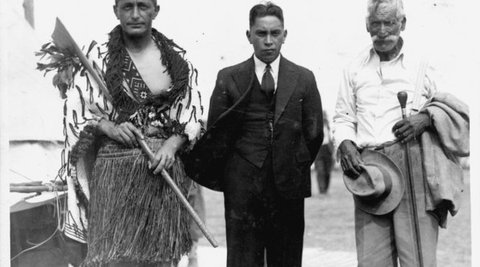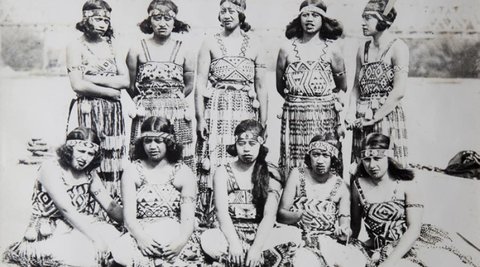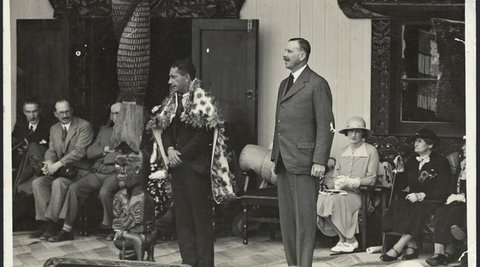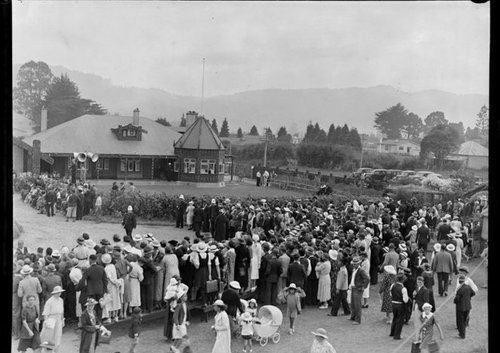
Radio broadcasts began in New Zealand in 1921, but recordings of broadcasts didn’t begin until 1935, when the National Broadcasting Service bought recording equipment. Prior to that all radio broadcasts went out live-to-air and were not captured in any way. With the new disc recording equipment, significant radio broadcasts could be recorded, and therefore potentially, archived.
The earliest broadcast recording archived in our Ngā Taonga Kōrero collection (the archive of RNZ’s Māori radio programmes) is from the hui held at Ngāruawāhia in March 1938, to mark the opening of Tūrongo, the house built at Tūrangawaewae Marae as a home for King Korokī. It is this event that we have chosen as our first exhibition from Ngā Taonga Kōrero.
Hero Image: Turangawaewae Marae, Ngaruawahia, Waikato. (Alexander Turnbull Library, Wellington - WA-12568-G )
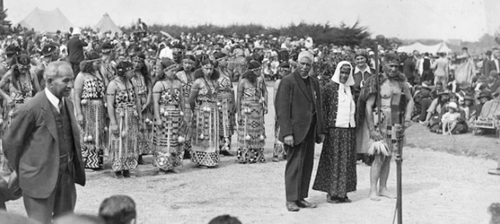
Opening ceremony for Turongo House at Turangawaewae Marae, Ngaruawahia, Waikato. (Dominion Post, Alexander Turnbull Library, Wellington )
The 1938 Tūrongo broadcast was transmitted by telephone line from Ngāruawāhia to station 1YA in Auckland. 1YA then relayed the broadcast to 2YA in Wellington, where it was recorded using the disc recording equipment. In the years before tape-recording technology, this meant cutting the sound by needle, into a large acetate or lacquer disc. The Tūrongo discs are 16-inches in diameter – something like a vinyl LP record, but larger and not flexible.
Each side of a 16-inch disc could only hold about 10 minutes of recording, so a long broadcast like this was recorded over many discs. In the recordings, you can occasionally hear commentator Charles Bennett telling the studio at 2YA to “Cut”, meaning he had reached a pause in proceedings at Ngāruawāhia and it was time for them to start a new disc.
These early recordings of significant hui and other Māori events, were often broadcast (and recorded and archived) at the request of Sir Apirana Ngata . He was a presence at nearly every Māori event recorded through the 1930s and 1940s. He is heard speaking at pōwhiri, performing in haka and translating whaikōrero into English for Pākehā guests. He was often the Master of Ceremonies and in the background of some recordings he can be heard over a loudspeaker directing visitors and performing groups, or organising dining arrangements .
Ngata encouraged the National Broadcasting Service to come to these important events, to broadcast and record them. He felt this was a way to ensure Māori oral traditions were captured and passed on to future generations. This work was supported by the first Director of Broadcasting, Professor James Shelley . At the opening of Tamatekapua meeting house at Ōhinemutu, Rotorua in 1943 Ngata sent a message to Shelley , praising the work of the broadcasting technicians and noting his belief that it was important to capture the many waiata, chants and speeches “before the generation who knows these things, passes away”.
These early recordings of the 1930s and 1940s form the basis of Ngā Taonga Kōrero. The historic hui they captured and the many outstanding examples of oratory and Māori performing arts recorded were a rich source of material for Māori radio programme makers over the following decades. In the 1950s, the recordings were drawn on for episodes of the series Ngā Pao me Ngā Pākiwaitara o Te Iwi Māori. In the 1960s when the first permanent Māori radio unit was set up, the pioneering Māori language programme, Te Reo o te Māori (hosted by Ted Nepia), and the simply named English language Māori Programme (hosted by Wiremu Parker and Wiremu Kerekere), all drew on these early recordings and re-used excerpts from them in multiple ways. Today, excerpts from these first Māori broadcasts are still being used and re-broadcast by new generations of broadcasters on iwi radio stations.
In 1991 the earliest of the Māori radio broadcasts were catalogued by Dr Mervyn McLean, in a collaboration between RNZ Sound Archives and The Archive of Māori and Pacific Music at the University of Auckland. The Archive has kindly permitted reproduction of some of that catalogue on these pages to help listeners follow the broadcasts.
With the assistance of Te Taura Whiri i te Reo Māori and support from iwi Māori and Radio New Zealand, Ngā Taonga Sound & Vision is progressively making these broadcasts available for online listening. We hope the spoken treasures contained in recordings of Ngā Taonga Kōrero collection will continue to inspire and educate as they were intended.
Charles Moihi Te Arawaka Bennett (Ngāti Whakaue, Ngāti Pikiao) is the commentator heard throughout these broadcasts. A pupil of Te Aute College, he graduated from Canterbury University College with a B.A. in 1936. Charles Bennett worked for the National Broadcasting Service as an announcer but within two years of the broadcast, he was serving overseas in the 28 Māori Battalion in World War II.

